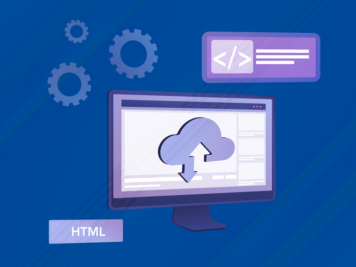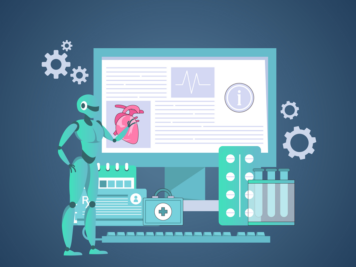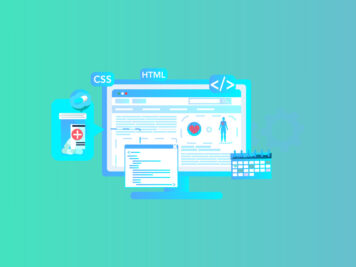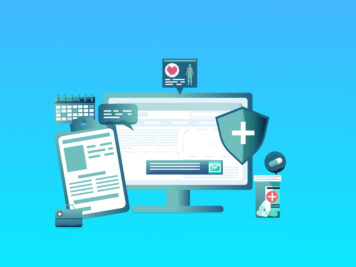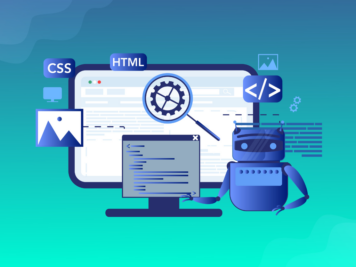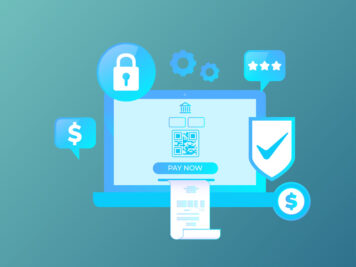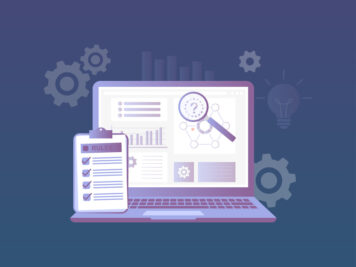The global healthcare IT market is projected to reach $974.5 billion by 2027, driven by the growing adoption of e-prescribing, mHealth, telehealth, and other HCIT solutions. Despite the optimistic prediction, healthcare software product development remains a challenging task. The process often gets affected with compliances, evolving patient needs, and continuous risk of data breaches. According to Statista, the US healthcare sector recorded the highest average cost of data breaches between March 2022 and February 2024, with a loss of $11 million. This highlights how crucial security is for creating healthcare software products, as a single mistake can have serious repercussions.
Innovation and security are the two sides of the same coin in healthcare. While innovation is necessary to drive progress, it must always be balanced with a commitment to patient data security. Building secure healthcare solutions is a necessity, rather than an option, in a regulated industry where fines are huge, and every breach has the potential to destroy patient trust. Beyond security, successful healthcare software products must be robust, scalable with evolving provider and patient demands, interoperable, and integration-ready with existing systems.
This blog shares insights from our experience with 200+ products, offering guidance on the technical, functional, and business sides of healthcare software development.
Essential considerations for healthcare software product development: Technical, functional and business factors
Technical, functional, and business factors are key when developing healthcare software solutions. Each of these is crucial to ensure your product meets industry standards and user requirements.
Let’s take a deeper look at each of them.
Technical considerations
In one of our projects, we had to identify the shape of cells and detect cells under mitosis. This was a challenging problem. We used classical image processing techniques for cell localization, image transformation and feature extraction. However, to classify the cells into different classes, we used the capabilities of a trained convolutional neural network. To detect similar regions in an H&E-stained tissue sample, we employed an unsupervised approach using a neural auto-encoder, which played the role of an image fingerprinting system.
But while solving the challenge, we ensured we maintained security standards, interoperability, and scalability. Also, we chose the right tech stack and architecture. These five considerations can make or break the AI model.
Security
Security is an important factor to consider during healthcare software product development. Your application will handle important patient information, and it is your obligation to keep it safe. Encryption stands out as one of the most effective techniques for protecting sensitive patient data. By converting data into code, encryption ensures that even if the data is intercepted, it remains illegible to unauthorized parties. This protects against data breaches and unauthorized access.
Another privacy measure is access controls, which specify who can view or use information within the software, ensuring that only authorized workers have access to certain data. For example, role-based access controls can restrict functionality depending on the user’s job within an organization, such as limiting access to patient information to only healthcare professionals.
Additionally, secure coding practices (such as input validation, proper error handling, and rigorous code reviews) are critical to avoiding vulnerabilities. Regular security audits, aided by automated techniques, help detect and manage potential threats, ensuring that software meets security standards over time. If you want to integrate AI into healthcare software applications, take even stricter data privacy protection measures. Methods like differential privacy can ensure that data remains protected even within AI models.
Interoperability and AI
Interoperability is the key to ensure seamless data exchange across healthcare systems. To achieve interoperability, healthcare software must comply with industry standards such as HL7 and FHIR. They provide compatibility with multiple platforms and applications. Interoperability improves the overall efficiency and accuracy of healthcare delivery by enabling healthcare professionals, institutions and organizations to share data.
AI integration plays a critical role in improving interoperability. AI-based models can evaluate massive data sets from multiple sources, including unstructured data, for insights and improve data sharing. But they must be integrated into healthcare systems in a way that respects strict privacy.
Tech Stack
Choosing the right technology stack is a crucial step in developing a successful healthcare software application. This involves selecting the programming languages, frameworks, and tools to be used.
For the front-end, technologies like HTML, CSS, JavaScript are popular choices due to their robust ecosystems and the level of interactivity they offer. Frameworks like ReactJS or Angular offer additional structure, components, and tools to streamline front-end development and enhance user experience.
On the back end, languages such as Node.js, Python or Java are often preferred for their scalability, versatility and strong community support. Node.js, a JavaScript runtime environment, especially well-suited for building real-time applications and APIs. Python is a popular choice for data analysis and machine learning tasks. Java is widely used for enterprise-level applications.
However, the choice of technologies often depends on factors such as project requirements, team expertise, and desired features. But it is critical to choose technologies that are current and show indicators of long-term viability. This ensures that the product is always up-to-date and manageable, making future updates and changes easier.
Architecture
Microservices, cloud-native architecture, and modular monoliths are popular approaches to managing complex and diverse tasks. While microservices provide flexibility and scalability, a modular monolith is useful for applications that require data security and consistency, such as patient data management.
When dealing with real-time data, relying solely on these cloud-based solutions can introduce latency. Edge computing can help solve this problem by processing data closer to the source, reducing delays and improving system responsiveness. This is especially critical for applications like medical device monitoring, which require real-time insights.
A well-designed architecture ensures that procedures run smoothly and makes it easy to scale the system to accommodate growing needs. Long-term maintenance and adaptability are also critical to the budget, as they allow the software to adjust to changing needs as the healthcare industry develops.
Scalability
Scalability sometimes requires a combination of methodologies and solutions specific to software requirements.
For example, adopting a microservices architecture allows various components of the application to be scaled separately, thereby maximizing resource usage. Load balancing is another important approach; dividing user requests across multiple servers ensures that no server becomes a bottleneck, preserving performance levels. Additionally, using cloud services such as AWS or Azure can simplify scaling efforts by automating resource provisioning based on current demand.
Large-scale applications such as electronic health record (EHR) systems and telehealth platforms are excellent examples of scalable solutions. These need to accommodate tens of thousands of concurrent users, particularly during peak times. These systems are able to provide continuous service by employing horizontal scalability, which involves adding more servers in response to increasing demand. Improving the overall scalability of healthcare software solutions is also greatly facilitated by techniques such as database sharding, which divides large databases into smaller, more manageable chunks.
Functional Requirements
It involves determining the most important functionalities and ranking them according to their importance to the user. This procedure ensures that the final product meets user requirements and offers a seamless experience for both medical professionals and patients.
Core features
The core features of a healthcare software product are the essential functionality that software must provide to meet the needs of healthcare professionals and patients. These typically include patient management, appointment scheduling, e-prescribing, and billing.
Ensuring that these features are well-defined and properly tested is critical to the success of the software. They must be easy to use and efficient, which will streamline healthcare operations and increase productivity.
User experience (UX)
59% of participants in a study published in PLoS One, downloaded and used between one and three health-related apps. 38.6% of these users use mobile health apps frequently, compared to 2.1% who use them infrequently. This demonstrates how important it is to offer a fun and intuitive mobile user experience.
For healthcare professionals, a well-designed UX ensures a more efficient workflow. For patients, this means a more engaging and accessible healthcare management tool. Prioritizing UX in the design process can result in higher quality treatment and healthier outcomes.
Workflow integration
Users are more likely to adopt products that are well integrated. Understanding the individual demands of healthcare professionals and their areas of expertise can lead to better designed processes, increasing overall efficiency and satisfaction with the software. Integration should be seamless and facilitate daily operations rather than hinder them.
Business considerations
In addition to functional requirements, several business considerations should also be considered during healthcare software product development.
Regulatory compliance
Healthcare software product development must comply with regulatory standards. Compliance ensures that patient data is managed legally and ethically, protecting against any legal challenges and penalties. It is critical to incorporate regulatory requirements into the development process from the beginning to avoid costly changes later on and to ensure that the software meets all legal responsibilities.
| Key regulatory considerations | |
| HIPAA (Health Insurance Portability and Accountability Act) | HIPAA sets the standard for securing sensitive patient information. Compliance ensures that healthcare software meets privacy and security standards, protecting patient information from unwanted access. |
| HITECH (Health Information Technology for Economic and Clinical Health Act) | HITECH encourages the use of EHRs and reinforces HIPAA requirements. It encourages healthcare organizations to use EHR systems while maintaining data privacy and security. |
| GDPR (General Data Protection Regulation) | The GDPR controls the data protection and privacy of individuals in the European Union. Healthcare software must be GDPR compliant to secure patient data and avoid hefty fines for non-compliance. |
| PIPEDA (Personal Information Protection and Electronic Documents Act) | PIPEDA governs how private sector companies handle personal information in Canada. Compliance ensures that healthcare software meets Canadian data protection regulations. |
| FDA (Food & Drug Administration) | The FDA oversees medical devices, including software classified as medical devices. Compliance ensures that healthcare software meets safety and efficiency requirements. |
Cost and ROI
Developing a healthcare software product requires a considerable investment of time, effort and money. It is therefore essential to carefully weigh the associated costs and ensure that they are justified by the expected return on investment. This may include researching the market, examining potential revenue streams and developing a sensible spending plan.
For example, before making a large investment, a healthcare service provider should conduct a detailed cost-benefit analysis, including potential savings from increased efficiency, better decision-making, and fewer errors. This could help in making more informed decisions about resource allocation and prioritizing AI efforts.
Time-to-market
Adopting effective development methodologies, such as Agile or DevOps, which prioritize iterative progress, frequent feedback, and streamlined procedures, is critical to achieving a rapid time-to-market.
Using cloud-based solutions, modular design principles, and prioritizing core features can further speed up the development time. Industries like healthcare demand flexibility as regulations and patient needs change frequently. Agile and DevOps methodologies help teams adapt quickly to compliance changes without losing reliability or security. This boosts development speed and balancing it with quality control and testing ensures both performance and security standards are met.
Support and maintenance
Regular updates are required to fix bugs, add new features, and ensure compliance with changing regulatory standards. To help users quickly resolve technical issues, a robust support system must be in place. This can promote patient and healthcare provider satisfaction and trust.
In telemedicine and triage, where immediate help is crucial, a strong support system reduces downtime and prevents glitches, improving patient care. Preventative measures like performance optimization and system monitoring further minimize interruptions. A thorough support and maintenance plan helps retain users, fosters goodwill, and encourages continued software use.
Key steps in healthcare software product development
Needs analysis and feasibility study
The first step in healthcare software development is to identify the needs of the organization. A thorough needs analysis and feasibility assessment will reveal the scope, objectives and potential issues of the project.
This step lays the foundations for a successful healthcare software product development process.
Design and prototyping
Design and prototyping involve crafting a precise software strategy that considers both end users and the internal team. The UI should prioritize simplicity and clarity, particularly for elderly users, with larger fonts, clear navigation, and accessible features for a user-friendly experience.
Internally, healthcare software needs seamless collaboration, so real-time updates and communication tools for efficient workflows should be central to prototypes. Early feedback from stakeholders during prototyping enables key revisions, ensuring both internal and external needs are met before full-scale development.
Development and implementation
Development involves integrating complex components that address healthcare’s real-world needs. Real-time data processing enables quick decisions in critical care, while AI improves diagnostics in areas like radiology. The system must efficiently handle large image files (e.g., CT or MRI scans) without compromising performance, considering the volume of healthcare data.
Implementation involves deploying the software in a live environment and training users for smooth data transitions across departments. This allows healthcare professionals to enhance data analysis, forecasting, and decision-making while maintaining patient care standards.
Testing and quality assurance
Testing and quality assurance (QA) are crucial for identifying and resolving issues before launch. Comprehensive testing ensures the software performs as expected in real-world situations, meets performance standards, and can handle the demands of healthcare environments. Functional, usability, and safety testing help prevent failures that could disrupt vital operations or hinder emergency services.
Deployment and integration
Deployment is the process of making software available to end users. Integration with current systems is essential to ensure efficient data flow and operation. Proper deployment and integration minimize disruption while maximizing the benefits of the software.
Maintenance and support
After launch, ongoing maintenance and support is essential to resolve issues, provide upgrades, and ensure continued functionality of the software. Regular maintenance keeps the software secure, up-to-date, and in step with changing healthcare demands.
Understand the cost of development
Healthcare software development comes with various related expenses. However, to give you an estimate, the projected cost of building a healthcare app is between $50,000 to $500,000. By understanding the main spending categories, you can create a more realistic budget.
Cost considerations:
Initial development costs
Initial development costs include design, prototyping, development tools, and development fees. These upfront costs provide the foundation for developing high-quality healthcare software.
Tech stack costs
Tech stack costs are influenced by the backend and frontend technologies used, as well as database and integration costs. Choosing the right technology stack is essential for performance and scalability.
Security and compliance costs
Implementing strict security measures, data protection policies, and regular audits results in security and compliance expenses. Compliance with the rules is essential to avoid sanctions and protect patient data.
Maintenance and support costs
Ongoing updates, user support, hardware maintenance, and future upgrades add to maintenance and support expenses. Regular maintenance ensures that the program continues to work correctly and safely.
Scaling and upgrading costs
Scaling the software for growth and integration of new features incurs scalability and upgrade expenses. These expenses ensure the program can adapt to new requirements and improve its capabilities.
Hidden costs
Unforeseen technological hurdles, regulatory complexity, and potential losses due to downtime add to the hidden costs. Contingency planning and proactive problem-solving can help reduce these expenses.
With a better understanding of expenses, you can calculate your healthcare software project’s return on investment (ROI).
Evaluation of return on investment and cost-benefit analysis
Factors to consider for ROI:
Automation
Automation simplifies operations, minimizes administrative tasks, and frees staff time to focus on patient care. It facilitates long-term cost savings by optimizing resource allocation and increasing efficiency.
Improved efficiency
Optimized workflows save time and resources, increasing overall efficiency. Data-driven insights enable more efficient resource allocation and cost-effective procedures.
Data-Driven Decisions
Advanced reporting and analytics provide insights that enable data-driven decision-making. These decisions help improve patient care, operational efficiency, and financial performance.
Note: By comparing the potential ROI against development expenses, you can make a more informed decision about investing in healthcare software.
Decision Point: Based on the ROI analysis, do the potential benefits outweigh the costs for your organization?
Consider development options: in-house or outsourced
There are two main ways for healthcare software product development: creating it in-house or outsourcing it to a healthcare software product development company.
| Factor | Consideration | In-house development | Outsourcing development |
| Team | Existing skills | Ideal for projects that match your team’s expertise. | Gain access to more experienced healthcare software product developers, some of whom may have unique skills that you don’t currently have in-house. |
| Project requirements | Project scope and duration | Suitable for major, long-term projects that require dedicated resources. | Ideal for one-off initiatives or projects requiring variable resources. Allow internal staff to focus on key responsibilities by outsourcing specific development tasks. |
| Budget | Cost considerations | Higher initial expenses for employment, infrastructure and tools. | Outsourcing can save you money, especially if you don’t have the necessary expertise in-house. You eliminate the hiring, training, and infrastructure expenses of building an in-house team. To get the best deal, keep agency costs in mind and work with a trusted vendor. |
| Company culture | Development philosophy | Ideal for projects that match your company’s culture and development style. | Although cultural differences may occur, appropriate vendor selection, based on demonstrated experience and communication style, can reduce these risks. |
| Control level | Communication and oversight | Ideal for critical tasks that require complete control and close communication. | Less control over the development process but strong communication protocols and project management technologies can help resolve it. |
| Security | Data protection | Low security risks with an in-house team. | Increased vigilance when it comes to data security is essential. Partnering with experienced outsourcing organizations with strict security policies reduces risk. |
Note: The best development strategy is determined by your unique requirements and priorities. However, for many healthcare companies, outsourcing provides a compelling path to developing high-quality, secure healthcare software, while saving money, accessing skilled expertise and reducing time to market.
If you think outsourcing makes more sense for you then selecting the right development partner is critical to project success.
Choosing the right development partner
Find a development partner who has the knowledge, experience, and dedication to deliver a high-quality, compliant healthcare software solution. Carefully evaluate potential partners using a set of predetermined criteria to ensure they meet your unique needs and expectations.
Here are few factors to consider before making this decision:
Technological experience
The right development partner possesses strong technical skills. When choosing a development partner, ensure they have deep expertise in the latest technologies and tools essential for cutting-edge financial software development. This involves knowledge of blockchain, cybersecurity protocols, artificial intelligence and data analysis. Their ability to efficiently use these technologies can impact the robustness, security, and efficiency of your financial software.
The best talents
Industry is evolving rapidly with new technologies. Only the brightest minds who can adapt and adopt will solve the challenges this creates. That’s why choosing a partner with top talent is critical. The team should include skilled developers, designers, engineers, and those experienced in healthcare. A team that understands healthcare’s unique challenges and regulations is more likely to deliver a solution that meets your needs.
Look for partners who invest in ongoing training and development to keep their teams up to date with industry trends.
Product mindset
Instead of focusing solely on task completion, the right development partner focuses on user experience and overall product success. They should be able to understand your company’s goals and translate them into an easy-to-use product. This includes iterative development, user testing, and dedication to improving the program based on feedback. A partner with a product mindset will work collaboratively with you to develop a solution that meets your demands and those of your consumers.
Innovation focus
In the healthcare industry, innovation is key. The industry is doing remarkable in terms of personalized care and medicines, among others. This might trigger the need for constant updates and changes in product structure. Your development partner should be proactive and ready to experiment with new ideas to keep your product competitive and cutting-edge. Innovation should also serve a purpose, delivering tangible value rather than being pursued just for the sake of it.
Conclusion
Investing in healthcare software product development is a strategic decision that can improve patient care, operational efficiency and decision-making. Healthcare companies can make better decisions and promote innovation by knowing the essential features, development phases and regulatory landscape.
Choosing the right development partner and adhering to best practices ensures efficient software installation and long-term benefits. Investigate the ability of healthcare software to elevate your business and improve patient outcomes.
